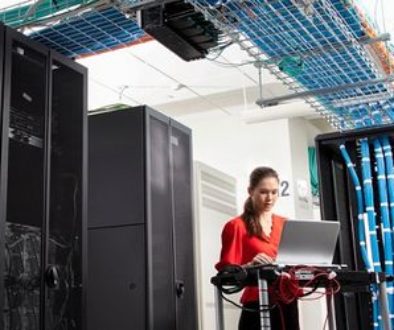Choosing between an all-flash array and hyperconverged
Often customers who need more storage or want to update old arrays ask this question: “Should I use an all-flash array (or some other external flash storage) or should I invest in a hyperconverged offering?” In this post, I want to give you some things to consider when making that choice.
If you want to listen to my “radio voice” reading this blog post, click here to listen to it.
At the beginning of the year, I had a blog post that looked at our all-flash array and flash storage portfolio that included some basic positioning of the MSA, HPE Nimble Storage, 3PAR, XP7 and HPE SimpliVity. If it’s not obvious, the MSA, Nimble Storage, 3PAR and XP7 are all disk arrays while SimpliVity is a hyperconverged solution.
I often hear customers who need more storage or want to update old arrays asking this question: “Should I continue to use an external storage array or should I invest in a hyperconverged offering?” In this post, I want to give you some things to consider when making that choice.
The basics
First, let’s define terms.
- Hyperconverged infrastructure: consolidated building blocks of storage and compute, which are managed and scaled together; for virtualized environments that prefer simultaneous storage/server refresh. It’s a software-defined platform that combines everything below the hypervisor. Our solution here, of course, is HPE SimpliVity.
- External disk array: standalone storage devices; for scaling and managing storage and compute separately; and sharing storage across multiple compute devices. Sometimes people call these a “SAN” but technically, a disk array usually connects to a SAN that allows sharing of storage with servers that are also connected to the SAN.
The fact that hyperconverged is a consolidated solution and a disk array is a standalone device sets the stage for key differences that will help you determine which solution to choose when.
- Since you scale a hyperconverged system by purchasing a new “node” or appliance, you are scaling storage and compute together.
- To scale a disk array, you purchase more drives. If the disk array is out of slots to add drives, you can add another enclosure and then add drives—assuming you have not hit the maximum supported drive count. Some disk arrays can add new controller pairs giving you more horsepower for IO performance. 3PAR is an example of that as it can scale from two to eight controller nodes.
Diving deeper
A couple of key things to consider when looking at hyperconverged and disk arrays are:
- Hyperconverged is for 100% virtualized environments—or at least an environment where you’d need other storage for non-virtualized applications, whether that is a disk array or storage internal to the server.
- Hyperconverged is ideal if you want to deploy co-provisioned server and storage solution in predictable increments and include robust data services for data protection.
- Hyperconverged could be a great fit for SMBs with a small IT staff but are highly knowledgeable about hypervisors. It can also be a good choice for enterprise remote/branch office locations or enterprise line of business.
- Disk arrays are ideal for businesses that prefer to keep storage and servers separate for more granular control of the environment and have specialists on site that can manage both. Disk arrays are also helpful when you do not know if you need to grow capacity versus growing compute. An external disk array allows storage performance and capacity expansion without a dependency on expanding compute.
1: Traditional criteria: capacity, resiliency, and performance
One thing that hasn’t changed over the years is the criteria that you should be considering when evaluating your options: capacity, resiliency, and performance. These “features” were important long before there was HCI, and I’m sure will continue to be so for years to come.
As you consider your options, you can put these criteria into a single point of scale. Scale capacity, scale performance, and scale resiliency. You need to understand what scale you need in your environment. And while this oversimplifies the issue, from a scale standpoint, I’d position HPE SimpliVity and Nimble Storage for customers that value simplicity and are willing to trade off configuration flexibility. 3PAR, on the other hand, provides a full feature set and configuration flexibility for the most demanding environments.
2: Technology vertical: virtualization, databases, cloud and mixed
Another facet of this discussion focused on technology workload. Here I’m talking about virtualization, databases, cloud or a mix of these. And here’s what you should think about—not as absolutes but for general guidance:
- Virtualization: Start with hyperconverged. Pivot to external disk arrays when enterprise scale matters.
- Databases: Start with external disk arrays. Database performance is still fastest on external block storage though running databases in a virtualized hyperconverged environment is also a choice.
- Hybrid cloud: Could be either. Look closely at the offerings to see what best meets your needs. There are use cases for backup to cloud with hyperconverged and disk arrays (e.g. HPE Cloud Bank Storage) that are really not very different.
- Mixed: Disk arrays. And, more specifically, advanced disk arrays like 3PAR though Nimble could meet your needs depending on your “scale” requirements.
3: Experience/expertise
I’ll preface this with a personal comment. I read lots of papers that focus on hyperconverged that all seem to have a common theme: storage is complex and hard. I don’t really agree with that. It depends. Sure, if you have an IT generalist or a VM administrator, managing an XP7 Disk Array would be a big challenge. Could they manage an HPE Nimble Storage array? I’m confident that answer is yes. I think this is especially true for iSCSI. When you throw Fibre Channel into the discussion that probably requires a storage expert.
With that, here’s some guidance:
- IT Staff who are “versatilists” in small to mid-sized organizations: Hyperconverged.
- IT Staff with some dedicated proficiency: Hyperconverged or simple disk arrays like HPE Nimble Storage or MSA.
- IT Staff with dedicated technology and business specialists: disk array (like 3PAR or XP7).
4: Putting it all together
I’ve talked about the three requirements as though they are separate discussions. But they all need to be factored in when making a decision on hyperconverged or external disk arrays. Some customers have advanced requirements with advanced needs but don’t have the IT skills to deploy and manage the individual components in a sophisticated system. Other customers have advanced needs with advanced IT skills but not the budget. Another customer might have simple needs but doesn’t have a handle on their future growth.
These “conflicts” can lead to making the wrong choice—and that was an issue long before we had hyperconverged as an option. I have seen more than a few customers talk about wanting 24×7 infrastructure and have a budget that wouldn’t get them to 8 hours x 5 days a week.
Making the right choice
Buying hyperconverged or a disk array comes down to what your needs are now—and what they’re going to be in a few years. You also have to consider your skill set, the number of IT staff members you have, their current workload and the directions they need to grow, technically speaking. And the tradeoff that always comes into play is your budget.
Once you’ve taken all of this into account, you should be closer to making the right choice.
Some closing thoughts
The thing that sets HPE apart is we have leading solutions across all of these areas I’ve touched on:
- Servers: HPE has led in the server market for years. And the ProLiant Gen10 servers won the CRN Tech Innovators Award for Datacenter Infrastructure. You can be confident in HPE’s compute options (which are an integral part of our hyperconverged systems).
- Storage: HPE is at the top right of the leader’s quadrant in the Gartner Magic Quadrants for General Purpose Arrays and is also in the leader’s quadrant in the Solid State Arrays MQ. Note that downloading these papers registration is required.
- Hyperconverged: HPE SimpliVity is in the leaders quadrant in the Gartner Magic Quadrant for Hyperconverged Infrastructure. Check out the blog post from Paul Miller, VP of Software Defined and Cloud Group, talking about it.



![picture2-1555105142615[1] picture2-1555105142615[1]](https://builddaylive.com/wp-content/uploads/2019/05/picture2-15551051426151-1024x255-394x330.png)